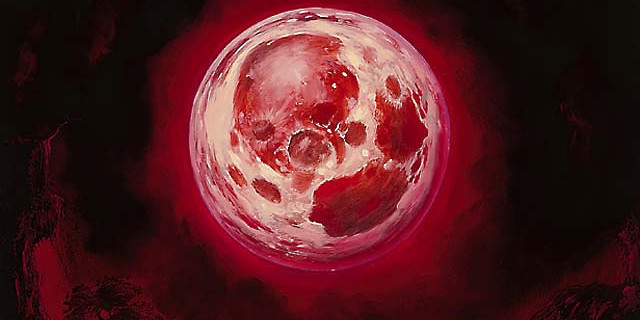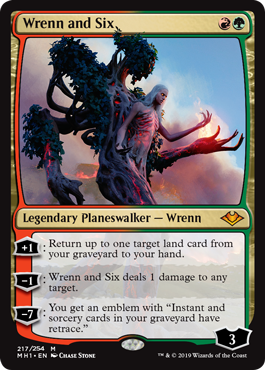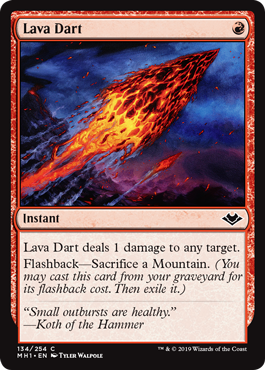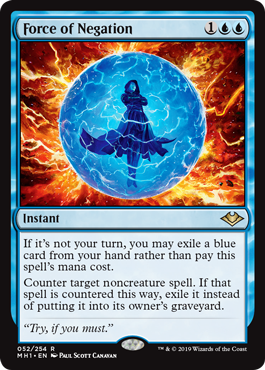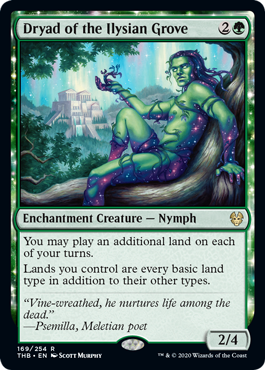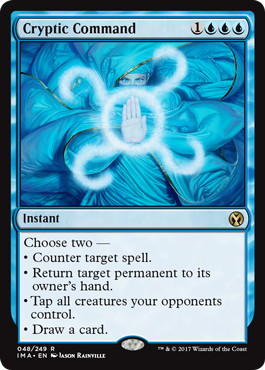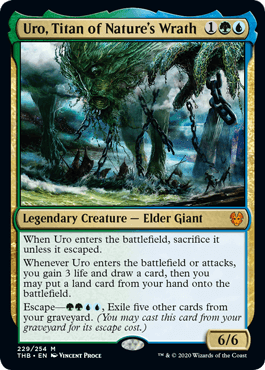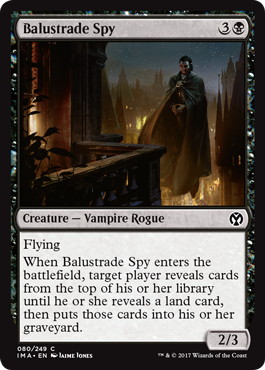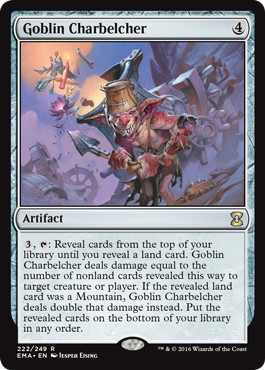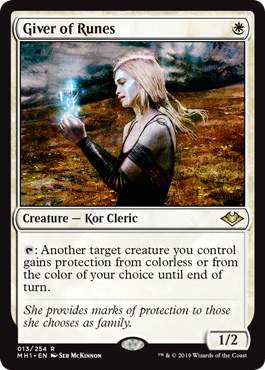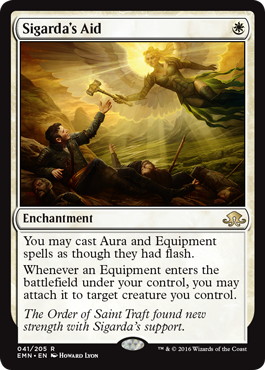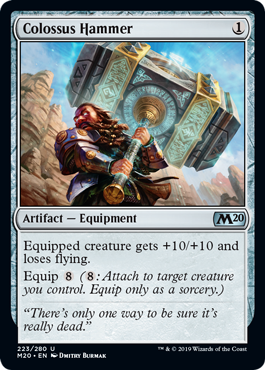Introduction
In just a month, Kaldheim releases, but even amidst the typically slower winter period with no new releases, Modern manages to change and evolve on a week to week basis. I’d like to go over the more visible trends in Modern and what to make out of them.
The Defining Cards
As is the case in any format, the most powerful interactive cards set the boundaries as to what is or isn’t an acceptable competitive strategy. Here are some cards that I think pose the biggest deckbuilding constraints in Modern currently:
《Wrenn and Six》《Lava Dart》
Since Modern Horizons and the introduction of both 《Wrenn and Six》 and 《Lava Dart》, Modern has become a really hostile place for one-toughness creatures. When skimming the list of most-played creature cards in Modern, cards that once appeared on top of the list like 《Dark Confidant》, 《Noble Hierarch》, or even the entire Humans deck are quite far down. Because both 《Wrenn and Six》 and 《Lava Dart》 are quite strong cards even without one-toughness targets to prey on, it’s hard to imagine metagames where it is very attractive to rely hard on one-toughness creatures.
《Force of Negation》
Similarly, the aforementioned set brought 《Force of Negation》 to Modern, which was a death’s kneel to strategies that really rely on resolving expensive Sorcery-speed threats. Namesake-based combo decks in the vein of KCI don’t frequently happen to be at the top of the metagame, but 《Force of Negation》 makes sure things will stay this way – I don’t think 《Krark-Clan Ironworks》 would be a strong deck in today’s Modern. Storm, Tron, Neoform, to a lesser extent Ad Nauseam, and some other decks are hindered by that cards’ existence quite a bit. Expensive planeswalkers are mostly played in blue decks that run 《Force of Negation》 themselves.
《Force of Negation》 is less universally good that 《Lava Dart》 and 《Wrenn and Six》, so it’s more likely to occasionally fall victim to its own success. Its existence pushes players towards aggressive 《Lurrus of the Dream-Den》 or creature-heavy decks, and occasionally blue decks trim 《Force of Negation》s.
《Blood Moon》
Besides those tools, there is an extra one I consider to be shaping the format heavily. For a while now, the strongest Modern strategies are ones focused around 《Field of the Dead》 and 《Mystic Sanctuary》. Lands aren’t always the easiest to interact with, but Modern has one frustratingly powerful tool: 《Blood Moon》.
According to metagame data aggregation sites, 《Blood Moon》 now resides within the top 10 of most played cards in Modern, as many strategies go-to answer to Control and Ramp decks. It started with Rakdos 《Death’s Shadow》s choosing to forego 《Lurrus of the Dream-Den》 in the post-board games, Obosh Prowess being main deck 《Blood Moon》 decks, even Selesnya Heliod occasionally splashing a third color to sideboard 《Magus of the Moon》 as a 《Collected Company》 hit.
New Decks in Modern
Rakdos Midrange
That brings us to the new midrange deck that’s throughout the past few weeks solidified its place in the Modern metagame:
The biggest new player: Rakdos Midrange
- Piotr Glogowski
- – Rakdos Midrange
- (Modern)
2 《Mountain》
4 《Bloodstained Mire》
4 《Polluted Delta》
3 《Blood Crypt》
4 《Blackcleave Cliffs》
-Land (22)- 4 《Magmatic Channeler》
3 《Kroxa, Titan of Death’s Hunger》
4 《Seasoned Pyromancer》
3 《Bonecrusher Giant》
-Creature (14)-
4 《Inquisition of Kozilek》
4 《Thoughtseize》
2 《Lightning Bolt》
1 《Cling to Dust》
2 《Dreadbore》
4 《Blood Moon》
3 《Liliana of the Veil》
-Spell (24)-
2 《Boil》
2 《Engineered Explosives》
2 《Nihil Spellbomb》
2 《Pithing Needle》
2 《Soul-Guide Lantern》
1 《Kalitas, Traitor of Ghet》
1 《Dreadbore》
1 《Dragon’s Claw》
-Sideboard (15)-
Modern Jund has been an underwhelming deck and a target of ridicule for a long time. Absolutely unable to grapple with late games of 《Primeval Titan》 and 《Uro, Titan of Nature’s Wrath》 decks was Jund’s biggest issue, and the introduction of main deck 《Blood Moon》s helps even out the matchup spread. A crucial part of the puzzle is that this deck forces your opponent not only to beat 《Blood Moon》s, but 《Blood Moon》s backed by a pile of discard spells.
While both Obosh Prowess and Gruul Ponza decks employed main deck 《Blood Moon》s successfully, it’s a much different game when you aren’t guaranteed to keep your answers to the enchantment in hand. As a result, having minimal ways to interact with 《Blood Moon》 while being cold to one that sticks is not really a viable strategy in Modern anymore.
This color combination is not bursting with powerful two mana proactive plays a midrange deck would be interested in. 《Dark Confidant》 would fill that role in the past, but as a one-toughness creature is good against exactly no decks. 《Magmatic Channeler》 from the new set steps in as a way to establish board presence and filter away dead lands and discard spells in the late game.
Rakdos is still relatively new and evolving, with a decent amount of variation in the exact composition of threats. I expect this deck to get better in the coming weeks as the threat suites get further ironed out.
Rakdos, and all the other 《Blood Moon》 decks being so popular means that Titan and Control decks can’t just take their late game for granted. You need to have solutions for the Moon, or otherwise, your strategy will fail. I expect slower decks to try to adapt to that in the coming weeks.
Four-Color Control
Because of how currently there exists not one, but two viable Rakdos decks, 《Celestial Purge》 becomes a great sideboard card, one of such possible adaptations. The last Modern Showcase Qualifier was won by a version four-color control running an entire playset in the sideboard, and while those small field tournaments obviously incentivize bolder metagame calls, I think it’s very reasonable to play that many even in broader fields, trying to overload their discard spells with quantity, moreso than quality, of answers.
In my experience, a mix of game one countermagic and 《Teferi, Time Raveler》, supplemented by sideboarded 《Celestial Purge》s is a strong plan for Four-Color in that matchup. This is how I’d like my Four-Color Control list to look like now:
- Piotr Glogowski
- – Four-Color Control
- (Modern)
1 《Island》
1 《Forest》
1 《Snow-Covered Island》
1 《Snow-Covered Forest》
1 《Ketria Triome》
1 《Raugrin Triome》
1 《Breeding Pool》
1 《Hallowed Fountain》
1 《Steam Vents》
1 《Stomping Ground》
1 《Temple Garden》
2 《Mystic Sanctuary》
4 《Flooded Strand》
4 《Misty Rainforest》
4 《Scalding Tarn》
2 《Field of the Dead》
1 《Field of Ruin》
-Land (29)- 3 《Uro, Titan of Nature’s Wrath》
2 《Omnath, Locus of Creation》
-Creature (5)-
2 《Lightning Bolt》
2 《Mana Leak》
4 《Growth Spiral》
3 《Force of Negation》
3 《Cryptic Command》
1 《Hour of Promise》
3 《Wrenn and Six》
3 《Teferi, Time Raveler》
1 《Jace, the Mind Sculptor》
1 《Teferi, Hero of Dominaria》
-Spell (26)-
3 《Aether Gust》
2 《Veil of Summer》
2 《Engineered Explosives》
2 《Soul-Guide Lantern》
1 《Mystical Dispute》
1 《Supreme Verdict》
-Sideboard (15)-
As for 《Primeval Titan》 decks, I wasn’t a huge fan of Amulet for a multitude of reasons already, but as the most 《Blood Moon》 vulnerable possible, I think it is exceptionally poorly positioned. 《Karn, the Great Creator》 can be used as a threat castable through 《Blood Moon》, but in my experience, the odds of 《Karn》 powering through 《Blood Moon》 alone are rather low, and it’s really hard to build an effective wishboard for Amulet.
The more popular Selesnya versions did a good job of beating up on Rakdos 《Death’s Shadow》 decks while being equipped with a pile of 《Celestial Purge》s in sideboard games, but answering main deck ones isn’t the easiest task. Including a main deck 《Skyclave Apparition》 to tutor for has a low opportunity cost, and it seems wise to play one or even two currently. While the WW cost is quite restrictive to fetch around early, 《Dryad of the Ilysian Grove》 can fix your mana for it through 《Blood Moon》.
Simic Titan
I myself tinkered a lot with Blue-Green Titan in the past month, and while I still have trouble understanding if the deck is actually any good, or I just enjoy it, but that take on Titan attempts to bridge early to mid-game with cheap counterspells and 《Cryptic Command》s stopping the combat step.
While not equipped to deal with main deck Moons perfectly, increasing the number of basic lands and ways to access them would be a way to address this problem, giving you outs to win game ones via countering the 《Blood Moon》, using 《Dryad of the Ilysian Grove》 to unlock 《Cryptic Command》 and bounce it, or just using basic land mana to Escape 《Uro, Titan of Nature’s Wrath》 and grind your opponent out.
- Piotr Glogowski
- – Simic Titan
- (Modern)
2 《Forest》
1 《Snow-Covered Island》
1 《Snow-Covered Forest》
1 《Zagoth Triome》
2 《Breeding Pool》
1 《Mystic Sanctuary》
4 《Misty Rainforest》
1 《Flooded Strand》
1 《Polluted Delta》
1 《Scalding Tarn》
1 《Verdant Catacombs》
1 《Flooded Grove》
1 《Simic Growth Chamber》
2 《Valakut, the Molten Pinnacle》
1 《Bojuka Bog》
1 《Castle Garenbrig》
1 《Oboro, Palace in the Clouds》
2 《Field of the Dead》
1 《Blast Zone》
1 《Field of Ruin》
1 《Radiant Fountain》
1 《Vesuva》
-Land (31)- 4 《Dryad of the Ilysian Grove》
4 《Uro, Titan of Nature’s Wrath》
4 《Primeval Titan》
-Creature (12)-
4 《Remand》
3 《Search for Tomorrow》
4 《Cryptic Command》
2 《Hour of Promise》
-Spell (17)-
3 《Chalice of the Void》
2 《Aether Gust》
2 《Mystical Dispute》
2 《Wheel of Sun and Moon》
2 《Engineered Explosives》
1 《Beast Within》
-Sideboard (15)-
The Glass-Cannon Combo
Release of Zendikar Rising and dual-faced land cards enabled Oops, all Spells and Belcher as two, somewhat similar glass-cannon strategies. While initially, it seemed like Oops was the stronger one of the two, given greater redundancy and resistance to 《Force of Negation》, recently combo champions like Sodek are swearing by Belcher’s position in the metagame instead.
While Belcher is quite weak to 《Force of Negation》, it is important to stay on top of the metagame. I wouldn’t trust Belcher to remain a consistently strong choice in the format, but whenever 《Force of Negation》 becomes generally worse, it is time for Belcher to strike. Newer builds of Belcher try to address the 《Force of Negation》 problem with main deck 《Pact of Negation》 and (again!) 《Blood Moon》s, which they can use to overload countermagic.
In Oops all spells, your kill mechanism alone takes 20 slots, so there is much less wiggle room to adapt and sideboard.
While I wouldn’t exactly call Belcher a tier one deck, I think it slots into the metagame space previously occupied by Neoform, as it’s a much more consistent and overall better version of a glass cannon combo deck.
Mono White Hammer
Another deck that quickly has taken over Modern, quickly ascending from a position of a meme deck to a serious contender, is Mono White Hammer.
- Laplasjan
- – Mono White Hammer
- Modern Challenge #12242683
- (3rd)
1 《Godless Shrine》
4 《Marsh Flats》
2 《Windswept Heath》
4 《Silent Clearing》
4 《Inkmoth Nexus》
-Land (21)- 4 《Ornithopter》
3 《Memnite》
4 《Giver of Runes》
4 《Puresteel Paladin》
4 《Stoneforge Mystic》
-Creature (19)-
4 《Sigarda’s Aid》
4 《Mishra’s Bauble》
4 《Colossus Hammer》
3 《Springleaf Drum》
1 《Shadowspear》
-Spell (20)-
4 《Thoughtseize》
3 《Pithing Needle》
2 《Fatal Push》
1 《Duress》
1 《Lurrus of the Dream-Den》
-Sideboard (15)-
While initially, it might seem like a joke deck, It has proven itself through consistent strong finishes in Modern Challenges. If you look closely, you’ll see that it checks all the boxes – as a cheap 《Lurrus》 deck it’s not weak to 《Force of Negation》, it’s mostly a monocolored deck that shrugs off 《Blood Moon》, and it’s not even particularly vulnerable to 《Lava Dart》!
While it might seem glass-cannon and exceptionally weak to removal at first glance, I think the strength of Hammertime lies in how deceptively resilient it can be.
Between 《Giver of Runes》, instant speed 《Colossus Hammer》s, 《Puresteel Paladin》‘s redraws and re-equipments, 《Lurrus》 and sideboard discard spells there is a quite large amount of counterplay to removal. I think this deck’s success is no fluke, and it’s there to stay, occupying the space of an interaction-checking deck like Infect traditionally did.
Conclusion
That’s all I have to say for today! Staying on top of Modern’s metagame is quite challenging and fun even in those online-only times, and necessary if you want to succeed in Challenges, PTQs, or periodical MTGO Showcase events.
Take care and until next time,


